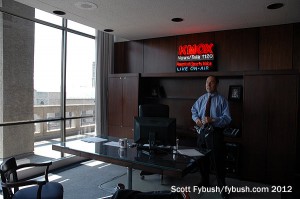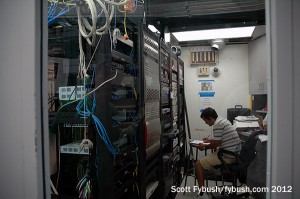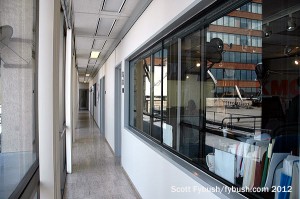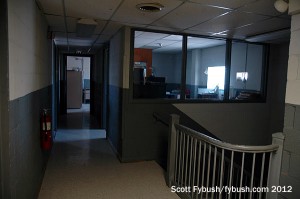Text and photos by SCOTT FYBUSH
When we set out to plan our travel for 2012, there were three “not going to be around much longer” sights that we were determined to get to. By that spring, it was clear the clock was ticking down on the KBRT (740) site off the coast of southern California, the historic KXAS (WBAP-TV) studios in Fort Worth, Texas and the One Memorial Drive studio home of KMOX (1120) in St. Louis, Missouri. I’ll spare you the suspense: I did indeed make it to all three, though it took two West Coast trips to notch what turned out to be a fantastic KBRT tour, and you’ll see our KXAS visit later on here on the site.
But as it turns out, KMOX was the first item we were able to check off our mini-bucket list for the year, and we’re glad we did. “One Memorial Drive” is one of the most hallowed addresses in American broadcasting, having served as home to CBS Radio’s KMOX (1120 St. Louis) and to its erstwhile FM and TV sister stations as far back as 1968.
I’ll defer, for the most part, to Frank Absher’s excellent STLMediaHistory site for lots of historic detail about KMOX’s early days; suffice it to say that on the studio end, KMOX arrived here at the edge of the Mississippi River after eight years in a purpose-built brick building on Hampton Avenue, west of downtown and just south of Forest Park. Before that, it had spent just a couple of years at 906 Sidney Street, and before that, from 1931 until 1957, KMOX made its home in the hulking Mart Building, just west of the present site of Busch Stadium.
The move to the “Gateway Tower” building, a 20-story behemoth right next to the new Arch, finally united KMOX and KMOX-FM (103.3) with their CBS TV sister station, KMOX-TV (Channel 4). Channel 4 was a late addition to the CBS family, having signed on in 1954 as KWK-TV, sister to a different radio station, KWK (1380). In 1958, CBS abandoned its construction permit for channel 11 in St. Louis and bought channel 4 instead; channel 11 ended up as independent KPLR-TV. (The old channel 4 building at 1215 Cole eventually ended up as home to Sinclair’s ABC affiliate, KDNL-TV 30.)
But while AM, FM and TV were all under the same (very tall) roof, they remained distinctly separate operations – and that’s because the man at the helm of KMOX radio for many decades was the one and only Robert Hyland. Hyland operated with remarkable autonomy from his nominal bosses in New York, thanks to the remarkable profits KMOX(AM) produced, and that allowed him to run the AM station as his own personal fiefdom, all by itself on the third floor of the building, upstairs from KMOX-TV.
The office Mr. Hyland built himself in 1968 still existed almost intact on this blazing summer day in 2012, straight down the hallway from the lobby. (“Almost” intact because when Hyland retired, he took his massive collection of Steuben art glass with him.) The walk down the hallway, along the front of the building, takes us past the prep area for the KMOX talk staff – and past a break room, where a framed set of letters takes pride of place on one wall.
It’s straight out of the KMOX HR file, circa 1977, documenting the attempts of a small-town Missouri DJ-turned-talk host to get hired at the Mighty MOX, only to be rejected by Hyland as not yet seasoned enough for the big show.
That hopeful young talent was one “Rush H. Limbaugh III,” and being rejected by Hyland set him on a path to Sacramento and then New York, and of course eventually to the national syndication that did finally get him on KMOX’s airwaves. (It’s said he had a nice chuckle about the letters when he visited KMOX many years later.)
While Mr. Hyland’s old office on the northeast corner of the building, had the most dramatic view across the street to the Arch, others got to enjoy the spectacular vista, too. Around the corner from the management offices, along the east wall facing the Arch and the riverfront, the KMOX newsroom also looked out through floor-to-ceiling glass. It opened, in turn, to a small rack room and into the studio complex set back from a corridor along the south wall of the tower.
The KMOX studios may not have had the dramatic Arch view, but they did open onto a flag-bedecked patio surrounding the radio and TV stations’ satellite dishes, up on the roof above the channel 4 studios downstairs.
(The patio was also sometimes used for staff parties, and I’m told it was a great place to watch fireworks over the Arch on July 4, too.)
That was Studio B (below at right) on the southeast corner of the complex, with a producer booth looking into it, surrounded by smaller news booths.
Down the hall, we passed additional production studios, engineering offices and took a peek at the history being stored in an upstairs storage area before looping around to the front lobby and our farewell to this piece of broadcast history. As nice as the view was here, it didn’t make sense for KMOX to stay: it hadn’t been associated with the TV station downstairs since 1985, when CBS sold channel 4 to Viacom, which changed its calls to KMOV. The former KMOX-FM, which had been upstairs in its own space on the seventh floor, was spun off to Clear Channel in the 1990s after CBS’ acquisition of American Radio Systems put it over the ownership cap – and by 2012 CBS wanted to move KMOX in with the ARS FM stations that stayed with CBS, KYKY (98.1) and KEZK (102.5).
There wasn’t enough room to do that at either Gateway Tower or the existing KEZK/KYKY studio (which we’ll see in our next installment), and so KMOX moved out in October 2012, taking up residence a dozen blocks to the west in the Park Pacific Building at Tucker and Olive, where the FM stations joined it early in 2013.
While KMOX’s long residence at Market and Memorial is now history (and its 12,000 square feet on the third floor are still for rent), the even longer history of its transmitter site across the Mississippi River in Pontoon Beach, Illinois lives on.
As with so, so very many of the old I-A clear channels, KMOX moved from an original 50 kW site before settling down in the 1940s. After leaving its initial transmitter site west of St. Louis in Kirkwood (source of the semi-apocryphal story that the calls stand for “Kirkwood, Missouri on Xmas,” marking the sign-on date of Dec. 25, 1925), KMOX spent the 1930s and most of the 1940s operating from a site near the Meramec River 12 miles south of town. Once the FCC moved away from the original idea that 50,000-watt stations needed to be located far from city centers to avoid overloading radios, KMOX made its final move in 1947, relocating to a site in the swampy land six miles east of the Mississippi in an area then known as Stallings, Illinois, and now as Pontoon Beach.
When this brick transmitter building was new, there was lots of Art Deco glass block, much of which has been bricked in over the decades as the site transitioned from manned operation to remote control. The Westinghouse 50-HG transmitter that filled the transmitter room is long gone, replaced in 1973 by a Gates MW-50 and later by Harris DX-50 and then 3DX-50 boxes, the latter hard to see in our wide shot of the room above, since it’s tucked in behind a rack.
As with many sites of this era, most of the activity took place on the second floor, where the big transmitter room sat at one end of the building, with engineering offices (now being repurposed as an emergency studio/newsroom) and a well-appointed engineering shop at the other end. Downstairs was where the power transformers sat, and it’s still where the HVAC and generator are to be found.
If KMOX’s tower looks far less than impressive, especially in the wide shots higher up on the page, there’s a very good reason: this is not the original tower from 1947. That one was reportedly not new even then, having been removed from WBBM up in Chicago and rebuilt down here at the other end of the state; in the late 1990s, CBS replaced that fat tower with the skinnier, unpainted, strobed model seen here today. But the tower base is original, and so is the doghouse at the base, from which so many years of full-service radio beamed out to the great Midwest.
Thanks to KMOX’s Joe Geerlings, Mike Waldman and Steve Moore for the tour!
THE 2025 TOWER SITE CALENDAR IS SHIPPING NOW!

Behold, the 2025 calendar!
We chose the 100,000-watt transmitter of the Voice Of America in Marathon, right in the heart of the Florida Keys. This picture has everything we like in our covers — blue skies, greenery, water, and of course, towers! The history behind this site is a draw, too.
Other months feature some of our favorite images from years past, including some Canadian stations and several stations celebrating their centennials (can you guess? you don’t have to if you buy the calendar!).
We will ship daily through Christmas Eve. Place your order now for immediate shipping!
This will be the 24th edition of the world-famous Tower Site Calendar, and your support will determine whether it will be the final edition.
It’s been a complicated few years here, and as we finish up production of the new edition, we’re considering the future of this staple of radio walls everywhere as we evaluate our workload going forward.
The proceeds from the calendar help sustain the reporting that we do on the broadcast industry here at Fybush Media, so your purchases matter a lot to us here – and if that matters to you, now’s the time to show that support with an order of the new Tower Site Calendar. (And we have the new Broadcast Historian’s Calendar for 2025 ready to ship, too. Why not order both?)
Visit the Fybush Media Store and place your order now for the next calendar, get a great discount on previous calendars, and check out our selection of books and videos, too!
And don’t miss a big batch of St. Louis IDs next Wednesday, over at our sister site, TopHour.com!
Next week: More St. Louis, 2012































